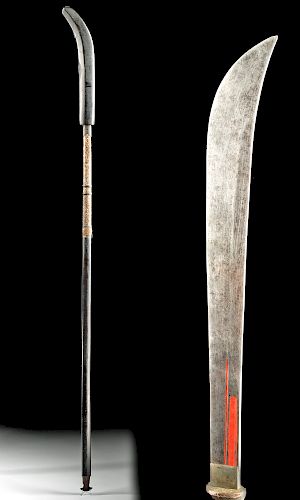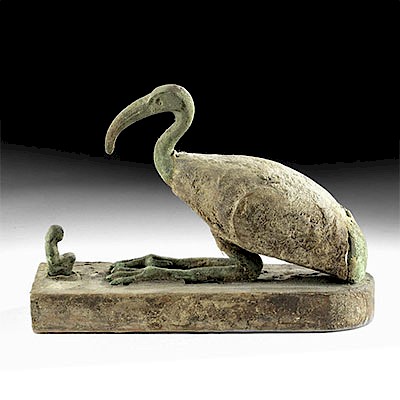Japanese Edo Wood, Iron, Steel & Nacre Naginata
Lot 156
About Seller
Artemis Gallery
686 S Taylor Ave, Ste 106
Louisville, CO 80027
United States
Selling antiquities, ancient and ethnographic art online since 1993, Artemis Gallery specializes in Classical Antiquities (Egyptian, Greek, Roman, Near Eastern), Asian, Pre-Columbian, African / Tribal / Oceanographic art. Our extensive inventory includes pottery, stone, metal, wood, glass and textil...Read more
Categories
Estimate:
$2,000 - $3,000
Absentee vs Live bid
Two ways to bid:
- Leave a max absentee bid and the platform will bid on your behalf up to your maximum bid during the live auction.
- Bid live during the auction and your bids will be submitted real-time to the auctioneer.
Bid Increments
| Price | Bid Increment |
|---|---|
| $0 | $25 |
| $300 | $50 |
| $1,000 | $100 |
| $2,000 | $250 |
| $5,000 | $500 |
| $10,000 | $1,000 |
| $20,000 | $2,500 |
| $50,000 | $5,000 |
| $100,000 | $10,000 |
| $200,000 | $20,000 |
About Auction
By Artemis Gallery
Oct 31, 2019
Set Reminder
2019-10-31 10:00:00
2019-10-31 10:00:00
America/New_York
Bidsquare
Bidsquare : Fine Antiquities, Asian, Ethnographic Art
https://www.bidsquare.com/auctions/artemis-gallery/fine-antiquities-asian-ethnographic-art-4581
Our Halloween Day auction features classical antiquities, ancient and ethnographic art from cultures encompassing the globe, plus fine art. Artemis Gallery info@artemisgallery.com
Our Halloween Day auction features classical antiquities, ancient and ethnographic art from cultures encompassing the globe, plus fine art. Artemis Gallery info@artemisgallery.com
- Lot Description
East Asia, Japan, Edo Period, ca. 1603 to 1868 CE. A beautiful example of a "naginata" (literally "mowing down sword" or "reaping sword"). The lacquered wooden pole has an iron pommel in the shape of a crescent, a midsection that is tightly wrapped with twisted string, and an upper body that features hundreds of petite inlaid nacre fragments. The lengthy steel blade has a lightly curved profile, a sharpened edge, a thick spine, and a pointed tip, with two grooves along each side filled with vermilion-hued lacquer. A form-fitting blade sheath accompanies the weapon and boasts lustrous black-lacquered surfaces. Size: 2.25" W x 70.75" H (5.7 cm x 179.7 cm).
According to ancient weapons expert Harvey J.S. Withers, "[The naginata] was a common polearm used by Samurai warriors and is most commonly associated with the Kamakura and Muromachi Periods (1338-1573). The naginata comprised a lacquered (sometimes inlaid with mother-of-pearl) wooden pole approximately 2m (6.5 ft) in length. Onto this was forged a curved blade in very much the same way as traditional katana blades - and, indeed, many naginatas were actually mounted with recycled katana blades. The blade, or nakago, or a naginata was secured onto the pole by a single peg, or mekugi." (Withers, Harvey J.S. "The Illustrated Encyclopedia of Swords and Sabres." Lorenz Books, London, 2010, p. 80)
Provenance: private J.H. collection, Beaverton, Oregon, USA
All items legal to buy/sell under U.S. Statute covering cultural patrimony Code 2600, CHAPTER 14, and are guaranteed to be as described or your money back.
A Certificate of Authenticity will accompany all winning bids.
We ship worldwide and handle all shipping in-house for your convenience.
#149822Chipping to some lacquered areas, nacre inlays, and blade sheath, with minor abrasions to handle, and slight bending to overall form of blade. Nice patina throughout.Condition
- Shipping Info
-
All shipping is handled in-house for your convenience. Your invoice from Artemis Gallery will include shipping calculation instructions. If in doubt, please inquire BEFORE bidding for estimated shipping costs for individual items.
-
- Buyer's Premium



 EUR
EUR CAD
CAD AUD
AUD GBP
GBP MXN
MXN HKD
HKD CNY
CNY MYR
MYR SEK
SEK SGD
SGD CHF
CHF THB
THB















